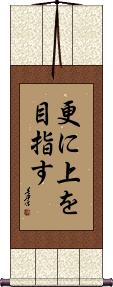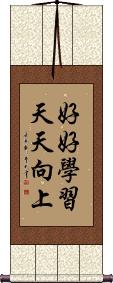Many custom options...
And formats...

Improving in Chinese / Japanese...
Buy an Improving calligraphy wall scroll here!
Personalize your custom “Improving” project by clicking the button next to your favorite “Improving” title below...
Always Try to do Better
This Japanese proverb literally translates as: [After having achieved a fair degree of success,] one should still try to do better.
Others may translate this as “Always try to improve,” or “Always try to be better.”
Note: Because this selection contains some special Japanese Hiragana characters, it should be written by a Japanese calligrapher.
See Also: Never Give Up
Good Good Study, Day Day Up
好好學習天天向上 is a famous proverb by Chairman Mao Zedong that sounds really strange when directly translated into English.
I include it in our database of phrases to illustrate how different the construction and grammar can be between Chinese and English. The direct translation is “Good Good Study, Day Day Up.” In Chinese, a repeated character/word can often serve to reinforce the idea (like saying “very” or suggesting “a lot of”). So “good good” really means “a lot of good.” While “day day” can be better translated as “day in day out.” The idea of “up” has a meaning in China of “rising above” or “improving.”
After understanding all of this, we come up with a slightly better translation of “With a lot of good study, day in and day out, we raise above.”
The more natural translation of this proverb would be something like, “study hard, and keep improving.”
Not the results for improving that you were looking for?
Below are some entries from our dictionary that may match your improving search...
| Characters If shown, 2nd row is Simp. Chinese |
Pronunciation Romanization |
Simple Dictionary Definition |
二利 see styles |
èr lì er4 li4 erh li ji ri |
The dual benefits, or profits: benefiting or developing oneself and others; 自利 in seeking enlightenment in bodhisattvahood, 利他 in saving the multitude. Hīnayāna "seeks only one's own benefit"; the bodhisattva rule seeks both one's own benefit and that of others, or personal improvement for the improving of others. |
利人 see styles |
lì rén li4 ren2 li jen rihito りひと |
(given name) Rihito To benefit or profit men, idem利他 parahita; the bodhisattva-mind is 自利利他 to improve oneself for the purpose of improving or benefiting others; the Buddha-mind is 利他一心 with single mind to help others, pure altruism; 利生 is the extension of this idea to 衆生 all the living, which of course is not limited to men or this earthly life; 利物 is also used with the same meaning, 物 being the living. |
十二 see styles |
shí èr shi2 er4 shih erh tooji とおじ |
twelve; 12 12; twelve; (given name) Tooji dvātriṃśa. Thirty-two. 三十二應 (or 三十二身) The thirty-two forms of Guanyin, and of Puxian, ranging from that of a Buddha to that of a man, a maid, a rakṣas; similar to the thirty-three forms named in the Lotus Sūtra. 三十二相三十二大人相 dvātriṃśadvaralakṣaṇa. The thirty-two lakṣaṇas, or physical marks of a cakravartī, or 'wheel-king', especially of the Buddha, i. e. level feet, thousand-spoke wheel-sign on feet, long slender fingers, pliant hands and feet, toes and fingers finely webbed, full-sized heels, arched insteps, thighs like a royal stag, hands reaching below the knees well-retracted male organ, height and stretch of arms equal, every hair-root dark coloured, body hair graceful and curly, golden-hued body, a 10 ft. halo around him, soft smooth skin, the 七處, i. e. two soles, two palms, two shoulders, and crown well rounded, below the armpits well-filled, lion-shaped body, erect, full shoulders, forty teeth, teeth white even and close, the four canine teeth pure white, lion-jawed, saliva improving the taste of all food, tongue long and broad, voice deep and resonant, eyes deep blue, eyelashes like a royal bull, a white ūrnā or curl between the eyebrows emitting light, an uṣṇīṣa or fleshy protuberance on the crown. These are from the 三藏法數 48, with which the 智度論 4, 涅盤經 28, 中阿含經, 三十ニ相經 generally agree. The 無量義經 has a different list. 三十二相經 The eleventh chapter of the 阿含經. 三十二相經願 The twenty-first of Amitābha's vows, v. 無量壽經. 三十三 trayastriṃśat. Thirty-three. 三十三天忉利天; 憺梨天, 多羅夜登陵舍; 憺利夜登陵奢; 憺利耶憺利奢 Trayastriṃśas. The Indra heaven, the second of the six heavens of form. Its capital is situated on the summit of Mt. Sumeru, where Indra rules over his thirty-two devas, who reside on thirty-two peaks of Sumeru, eight in each of the four directons. Indra's capital is called 殊勝 Sudarśana, 喜見城 Joy-view city. Its people are a yojana in height, each one's clothing weighs 六鐵 (1; 4 oz. ), and they live 1, 000 years, a day and night being equal to 100 earthly years. Eitel says Indra's heaven 'tallies in all its details with the Svarga of Brahminic mythology' and suggests that 'the whole myth may have an astronomical meaning', or be connected, with 'the atmosphere with its phenomena, which strengthens Koeppen's hypothesis explaining the number thirty-three as referring to the eight Vasus, eleven Rudras, twelve Ādityas, and two Aśvins of Vedic mythology'. In his palace called Vaijayanta 'Indra is enthroned with 1, 000 eyes with four arms grasping the vajra. There he revels in numberless sensual pleasures together with his wife Śacī... and with 119, 000 concubines with whom he associates by means of transformation'.; dvādaśa, twelve. |
增益 see styles |
zēng yì zeng1 yi4 tseng i zōyaku |
to increase; gain (electronics); (gaming) buff Increasing, improving. |
手浴 see styles |
shuyoku; teyoku しゅよく; てよく |
hand bath (for improving blood circulation) |
磨淬 see styles |
masai まさい |
(rare) polishing one's sword; improving one's talents or knowledge |
足浴 see styles |
zú yù zu2 yu4 tsu yü sokuyoku そくよく |
foot bath footbath (for improving blood circulation) |
鏤刻 镂刻 see styles |
lòu kè lou4 ke4 lou k`o lou ko rukoku; roukoku / rukoku; rokoku るこく; ろうこく |
to carve; to engrave (noun, transitive verb) (1) engraving; carving (into); (noun, transitive verb) (2) polishing (a piece of writing); improving |
不長進 不长进 see styles |
bù zhǎng jìn bu4 zhang3 jin4 pu chang chin |
not improving; backward; below par |
增上心 see styles |
zēng shàng xīn zeng1 shang4 xin1 tseng shang hsin zōjō shin |
Advancing or improving mind, superior mind. |
性懲り see styles |
shoukori / shokori しょうこり |
(usu. 〜もなく) (See 性懲りもなく・しょうこりもなく) repenting; improving one's nature |
普及啓発 see styles |
fukyuukeihatsu / fukyukehatsu ふきゅうけいはつ |
public awareness (e.g. publicity and education campaigns aimed at improving the health, environment, etc.) |
自利利他 see styles |
zì lì lì tā zi4 li4 li4 ta1 tzu li li t`a tzu li li ta jiri rita |
Self-profit profit others', i. e. the essential nature and work of a bodhisattva, to benefit himself and benefit others, or himself press forward in the Buddhist life in order to carry others forward. Hīnayāna is considered to be self-advancement, self-salvation by works or discipline; Bodhisattva Buddhism as saving oneself in order to save others, or making progress and helping others to progress, bodhisattvism being essentially altruistic. |
スキルアップ see styles |
sukiruapu スキルアップ |
(noun/participle) reskilling (wasei: skill-up); improving one's skills |
レベルアップ see styles |
reberuapu レベルアップ |
(noun/participle) raising the level (of) (wasei: level up); boosting; improving; improvement; rising to the next level |
增益己身灌頂 增益己身灌顶 see styles |
zēng yì jǐ shēn guàn dǐng zeng1 yi4 ji3 shen1 guan4 ding3 tseng i chi shen kuan ting zōeki koshin kanjō |
the consecration of improving one's condition |
日日に新なり see styles |
hibiniaratanari ひびにあらたなり |
(expression) (idiom) Keep improving day by day |
自利利他圓滿 自利利他圆满 see styles |
zì lì lì tā yuán mǎn zi4 li4 li4 ta1 yuan2 man3 tzu li li t`a yüan man tzu li li ta yüan man jiri rita enman |
perfection in the practices of improving oneself and bringing benefit to others |
キャリアアップ see styles |
kyariaapu / kyariapu キャリアアップ |
(noun/participle) career enhancement (wasei: career up); improving one's career prospects |
スキル・アップ see styles |
sukiru apu スキル・アップ |
(noun/participle) reskilling (wasei: skill-up); improving one's skills |
レベル・アップ see styles |
reberu apu レベル・アップ |
(noun/participle) raising the level (of) (wasei: level up); boosting; improving; improvement; rising to the next level |
勤修習利有情事 勤修习利有情事 see styles |
qín xiū xí lì yǒu qíng shì qin2 xiu1 xi2 li4 you3 qing2 shi4 ch`in hsiu hsi li yu ch`ing shih chin hsiu hsi li yu ching shih gon shushū ri ujō ji |
exert themselves in the task of improving [the spiritual condition] of sentient beings |
日々に新たなり see styles |
hibiniaratanari ひびにあらたなり |
(expression) (idiom) Keep improving day by day |
キャリア・アップ see styles |
kyaria apu キャリア・アップ |
(noun/participle) career enhancement (wasei: career up); improving one's career prospects |
Variations: |
sukiruapu; sukiru apu スキルアップ; スキル・アップ |
(n,vs,vt,vi) upskilling (eng: skill up); improving one's skills |
Variations: |
reberuapu; reberu apu レベルアップ; レベル・アップ |
(noun/participle) leveling up (wasei: level up); raising the level (of); boosting; improving; improvement; rising to the next level |
Variations: |
hibiniaratanari ひびにあらたなり |
(expression) (idiom) keep improving every day |
Variations: |
imeejiapu; imeeji apu イメージアップ; イメージ・アップ |
(n,vs,vi,vt) (ant: イメージダウン) improvement in image (of someone or something) (wasei: image up); improving one's image |
Variations: |
kyariaapu; kyaria apu / kyariapu; kyaria apu キャリアアップ; キャリア・アップ |
(n,vs,vi) career enhancement (wasei: career up); improving one's career prospects |
Variations: |
sheipuapu(p); sheepuapu / shepuapu(p); sheepuapu シェイプアップ(P); シェープアップ |
(n,vs,vi,vt) getting in shape (wasei: shape up); improving one's figure |
Click here for more improving results from our dictionary
The following table may be helpful for those studying Chinese or Japanese...
| Title | Characters | Romaji (Romanized Japanese) | Various forms of Romanized Chinese | |
| Always Try to do Better | 更に上を目指す | sara ni ue o me za su saraniueomezasu | ||
| Good Good Study, Day Day Up | 好好學習天天向上 好好学习天天向上 | hǎo hǎo xué xí tiān tiān xiàng shàng hao3 hao3 xue2 xi2 tian1 tian1 xiang4 shang4 hao hao xue xi tian tian xiang shang | hao hao hsüeh hsi t`ien t`ien hsiang shang hao hao hsüeh hsi tien tien hsiang shang |
|
| In some entries above you will see that characters have different versions above and below a line. In these cases, the characters above the line are Traditional Chinese, while the ones below are Simplified Chinese. | ||||
Successful Chinese Character and Japanese Kanji calligraphy searches within the last few hours...





